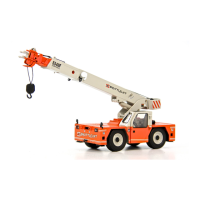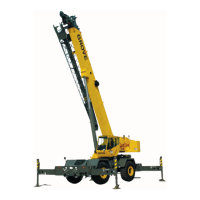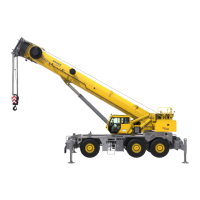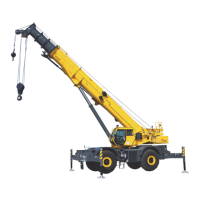3-9
TMS800E SERVICE MANUAL ELECTRIC SYSTEM
Published 01-29-2014, Control # 496-00
F303 (35A) is energized while the battery disconnect switch
is closed and protects the electrical circuits supplying power
to the superstructure cab and carrier cab.
F304 (100A) is energized when either key switch is in the
ignition “RUN” or accessory position and protects the
electrical circuits supplying power to the carrier and carrier
cab.
F305 (100A) is energized when either key switch is in the
ignition “RUN” or accessory position and protects the
electrical circuits supplying power to the superstructure and
superstructure cab.
Fuses F53 through F55 are located in the Fuse and Relay
Module #1. The rating of each fuse and the function or circuit
they protect can be found on the decal shown in (Figure 3-6
OR Figure 3-7).
F58 through F65 are located in the Fuse and Relay Module
#2. The rating of each fuse and the function or circuit they
protect can be found on the decal shown in (Figure 3-8).
Item 5 is the main power relay which provides power to most
of the crane's electrical circuits with the exceptions being the
engine ECM, starter, and all “battery hot” circuits. The relay's
contacts will close providing power to the circuits mentioned
above when its coil is energized. The coil will become
energized when any of the following conditions are met:
either key switch is turned to the ignition or accessory
position, or when the headlight switch, brake pressure switch
or hazard switch is actuated.
There are 6 additional relays, all located within the battery
compartment's (2) fuse and relay modules items 7 and 8.
Their descriptions and functions are listed on the fuse and
relay module's decals as shown in Figure 3-6, 3-7 and 3-8.
Superstructure Fuse and Relay Panel
Most superstructure electrical circuits are protected by the
components of the fuse and relay panel (Figure 3-5) located
at the rear of the superstructure cab. Access to all the fuses
may be gained by removing the small plastic cover on the
front of the panel. Inside the small plastic fuse cover, a fuse
decal as shown in Figure 3-9 can be found.
The fuse and relay panel contains 6 relays, 20 fuses (Items
1), a crane USB electrical diagnostic connector (Item 3), a
buzzer (Item 2), a diode module (Item 5) and a RCL override
key switch (Item 4).
Fuses
Fuses F101 through F103 are energized when the batteries
are connected.
Fuse F104 is energized when the batteries are connected
and the superstructure cab key switch is in the accessory
position.
Fuses F105 through F106 are energized when the batteries
are connected and the superstructure key switch is in the
ignition (RUN) position.
Fuse F106 is energized when the batteries are connected
and either the carrier cab or superstructure cab key switch is
in the ignition (RUN) position and the superstructure cab
emergency stop switch has not been activated.
Fuses F107 through F112 are energized when the batteries
are connected and either the carrier cab or superstructure
cab key switch is in the ignition (RUN) position or the
accessory (ACC) position.
Fuses F113 through F120 are energized when the batteries
are connected and the superstructure key switch is in the
ignition (run) position or the accessory (ACC) position.
The rating of each fuse and the function or circuit they
protect can be found on the decal shown in Figure 3-9.
Relays
Relay K101 provides power to fuses 107 through 112. This
relay's coil is energized when either key switch is positioned
to the ignition (RUN) position or the accessory position.
Relay K102 provides power to fuses 113 through 120. This
relay's coil is energized when the superstructure key switch
is positioned to the ignition (Run) position or the accessory
position.
Relay K103 through K106 are mounted on the rear side of
the fuse and relay panel.
Relay K103 is the superstructure key switch power supply
relay.
Relay K104 is the superstructure cab heater control motor
relay.
Relay K105 is the superstructure cab windshield wiper relay.
Relay K106 is the superstructure cab skylight wiper relay.
MAINTENANCE
General
Electrical system maintenance includes troubleshooting and
replacement of damaged components. Observe standard
wiring practices when replacing components.
CAUTION
If it is necessary to perform electrical maintenance on live
or hot circuits, remove all rings, watches, and other
jewelry before performing maintenance as serious burns
result from accidental grounding or shorting circuits.
Reference Only

